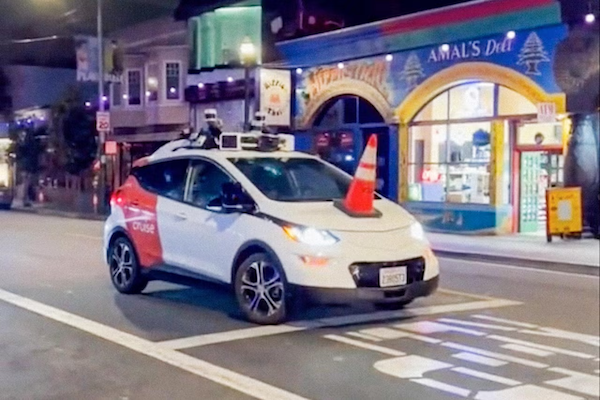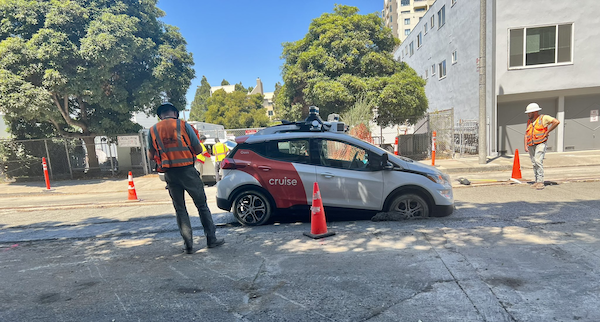

(quote)
The Self-Driving Cars Wearing a Cone of Shame
There’s a brilliant campaign to stop San Francisco’s autonomous vehicles in their tracks. Self-driving cars have met their match in the form of the humble traffic cone: a viral video of disabling autonomous Cruise and Waymo vehicles by placing bright orange traffic cones on their hoods.
The cones immobilize the autonomous vehicles by forcing them into “shutdown mode” with their hazard lights on, “until the cone is removed or a company technician comes to reset the car’s system,” the San Francisco Standard reported. Safe Street Rebel, the group behind the stunt, unleashed the cones last week ahead of a vote scheduled for Thursday by the California Public Utilities Commission that could allow Cruise and Waymo robotaxis unimpeded access to public streets in the city as the next phase of their development. Right now, Cruise (which is owned by General Motors) and Waymo (part of Alphabet, né Google) are offering limited service in San Francisco—a trial rollout that has caused enough actual chaos in the city to justify locals’ mistrust. “We want to either have [autonomous vehicles] not on the city streets at all or very limited,” one Rebel told the Standard. “It’s like the state has decided that these things are going to be deployed in San Francisco without the consent of the city or the people in it.”
A driverless Cruise car with no passengers got stuck in wet concrete at a construction site in San Francisco on Tuesday. Photos by local resident Paul Harvey show the front wheels of the vehicle sunk into the concrete on Golden Gate Avenue. “It thinks it’s a road and it ain’t because it ain’t got a brain and it can’t tell that it’s freshly poured concrete,” Harvey told SFGATE. “I thought it was funny,” Harvey told The Times. “I was kind of pleased because it illustrated how creepy and weird the whole thing is to me.”
Construction cones had been used to mark off the site and workers stood with flags at each end of the block, Rachel Gordon, a spokesperson for the San Francisco Department of Public Works, told The New York Times. She added that Cruise would have to pay for the affected portion of the road to be repaved.
This came just days after the California Public Utilities Commission gave autonomous-vehicle companies Cruise, owned by General Motors, and Waymo, owned by Google, the go-ahead to offer fare-charging driverless rides in San Francisco at any hour of day.
The CPUC decision has sparked concerns about the impacts driverless robotaxis could have on public safety, such as blocking access for emergency services. Gordon told The Times that some Cruise vehicles had driven onto fire hoses or “just stopped in the middle of the road.” Last week a group of about 10 cars created a traffic jam when they all stalled on a street, which Cruise attributed to “delayed connectivity” caused by a festival.
City Attorney David Chiu on Thursday filed an administrative motion asking the CPUC to halt its approval of Cruise and Waymo’s commercial expansion in San Francisco while the city seeks a rehearing of the decision. A rise in commercial AVs in San Francisco would “inevitably lead to an increase in traffic congestion and the number of dangerous incidents,” Chiu’s office said in a press release.
“We have seen that this technology is not yet ready, and poor AV performance has interfered with the life-saving operations of first responders,” Chiu said in a statement. “San Francisco will suffer serious harms from this unfettered expansion, which outweigh whatever impacts AV companies may experience from a minimal pause in commercial deployment.”
After disturbing week for Cruise robotaxis, state applies the brakes As a result, the California Department of Motor Vehicles said Friday it’s investigating “recent concerning incidents” involving Cruise vehicles while tapping the brakes on the company’s ambitious expansion plans.
The DMV didn’t say which incidents it’s probing, but over a seven-day period the events included:
— The bizarre, when a group of Cruise robotaxis drove together into the city’s North Beach district on the night of Aug. 11, froze in place, sat for 15 minutes blocking an intersection, then drove on. Cruise blamed cellphone service.
— The comic, when a Cruise robotaxi ignored construction signs on Tuesday and headed into a stretch of cement. Stuck in the wet muck, it was removed later by workers dispatched by Cruise.
— The alarming, when a Cruise robotaxi entered an intersection on a green light even as a fast-moving fire truck, lights flashing and siren blaring, approached. The truck struck the car, occupied by one passenger, who was transported to a hospital. Cruise said the passenger sustained “what we believe are non-severe injuries.”
The day after the injury crash, the DMV announced its investigation and said Cruise agreed to halve the size of its fleet, to 50 robotaxis during the day and 150 at night. State legislators are becoming fed up with the state of driverless vehicle regulation in California. A bill is moving through the Legislature that would require human safety drivers in driverless trucks for at least the next five years. State Sen. Lena Gonzalez has expressed concern about the way the DMV regulates Tesla safety. City officials in San Francisco, Los Angeles and Santa Monica and elsewhere are frustrated at how little control they have over robotaxi deployment in their cities.
(unquote)
Image courtesy Slate / TikTok and Carscoops / @Name_Is_Nobody






